Abstract
Squirrel monkeys were exposed to response-independent, fixed-frequency shock that produced biting attack upon a pneumatic hose. Attacks decreased within and across sessions at low intensities and high frequencies of shock, but increased within and across sessions at higher intensities and lower shock frequencies. Stimuli paired with shock, when presented alone, came to produce biting, and stimuli correlated with shock parameters that produced increases in responding within sessions produced similar increases when presented alone. Further experiments showed that continuing exposure to shock also produced lever pressing or chain pulling, with longer shock exposure again producing higher response rates. Whereas biting generally decreased throughout the intershock interval, manual responding generally increased as shock time approached, but immediately before shock was often suppressed. Following shock, biting attack predominated over manual behavior. The results suggest a possible explanation for the extreme resistance of avoidance behavior to extinction, and may also partially explain the persistence of responding during schedules of response-produced shock. Relationships of the present findings to naturalistic observations of relations between fleeing, freezing, and fighting performances are discussed.
Full text
PDF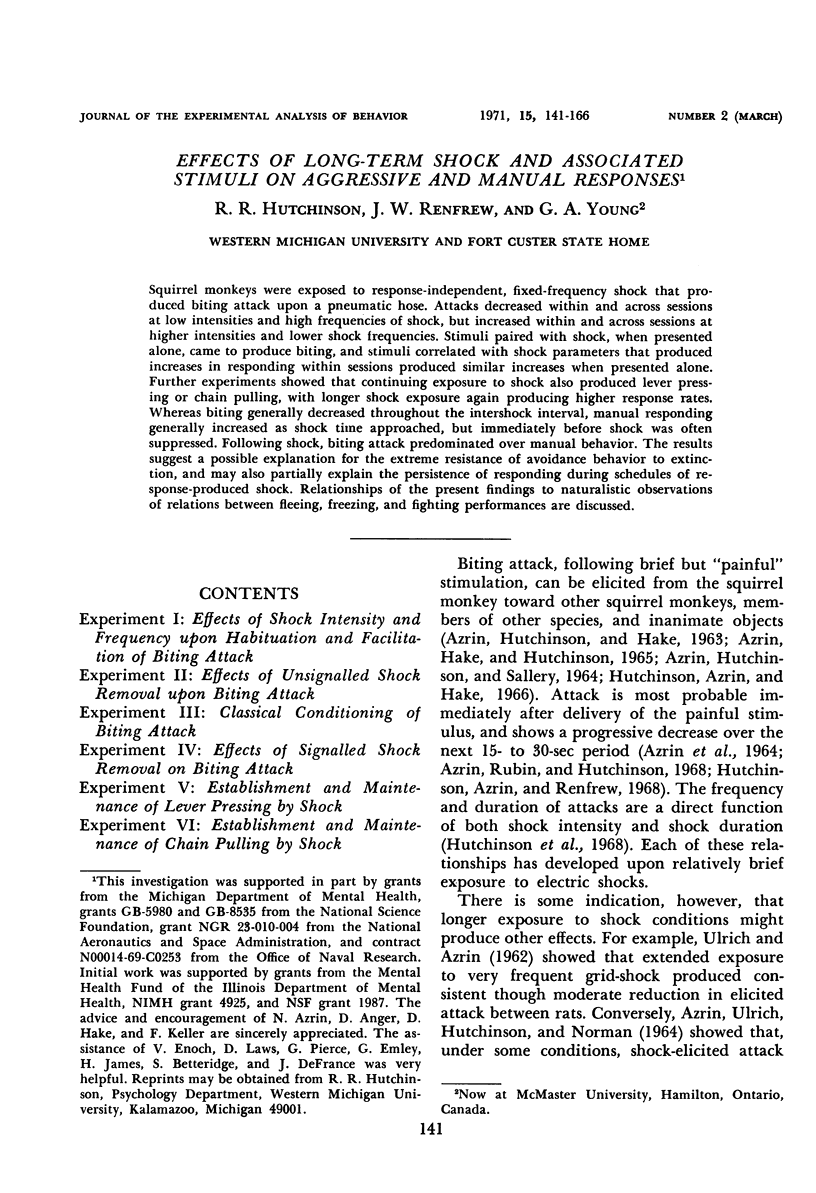
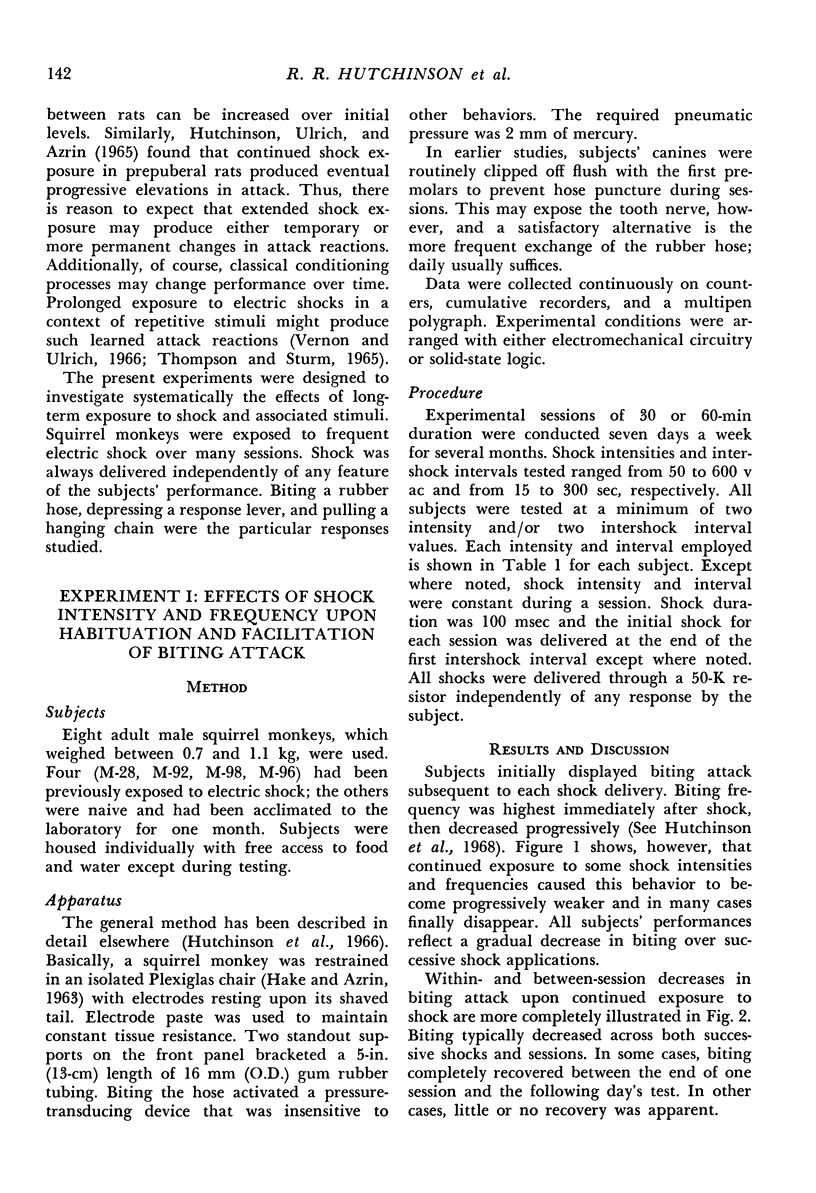

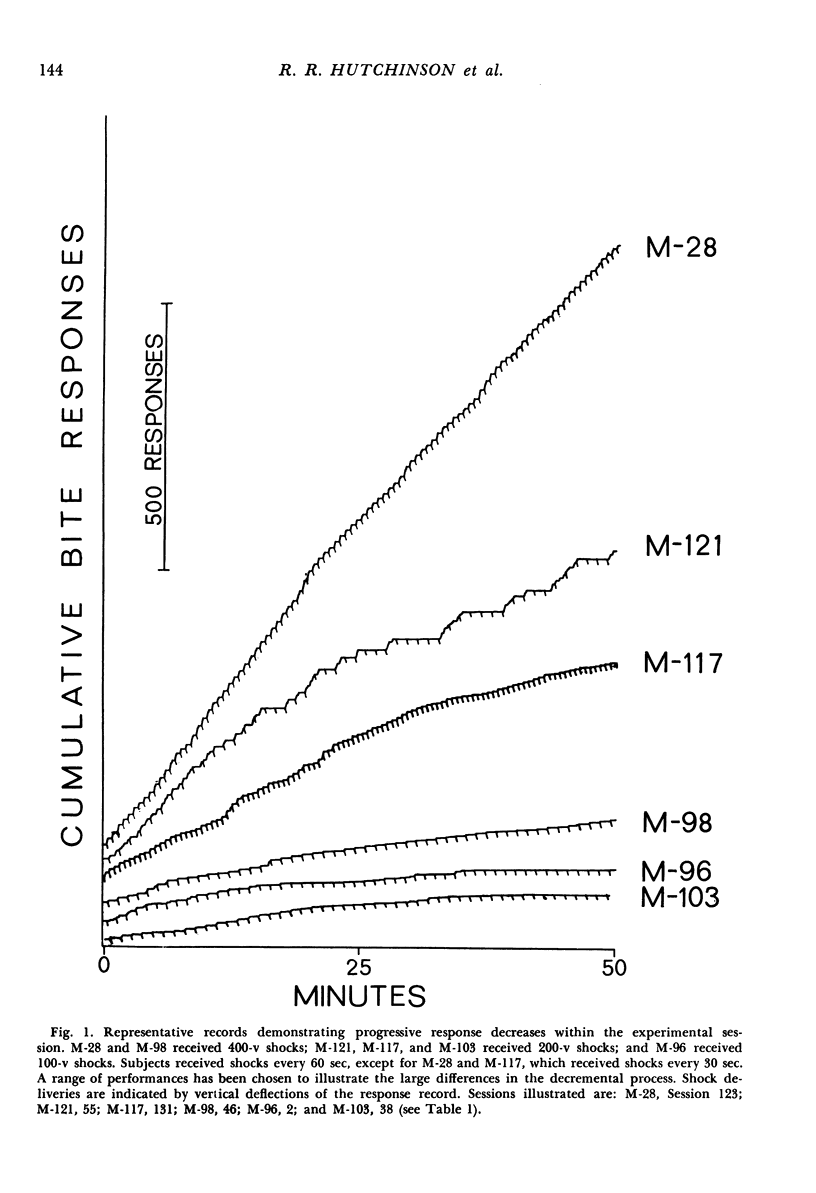


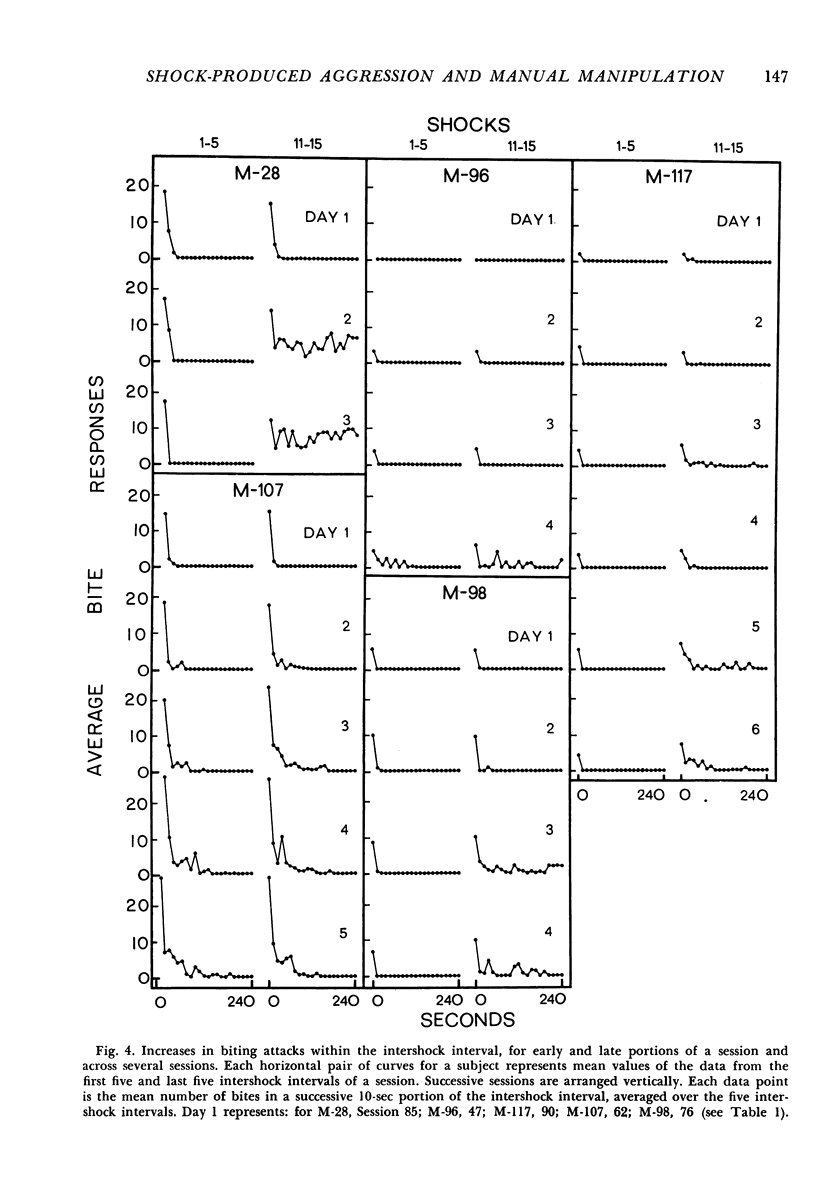
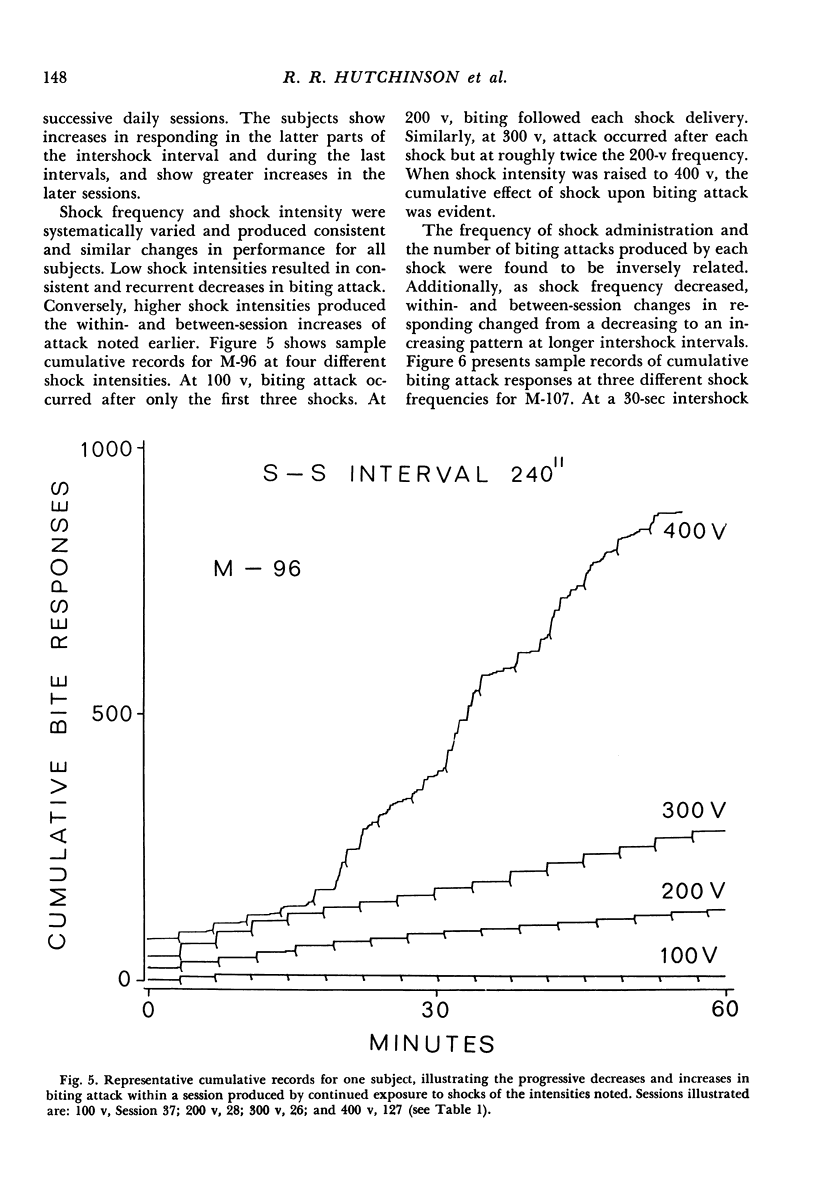
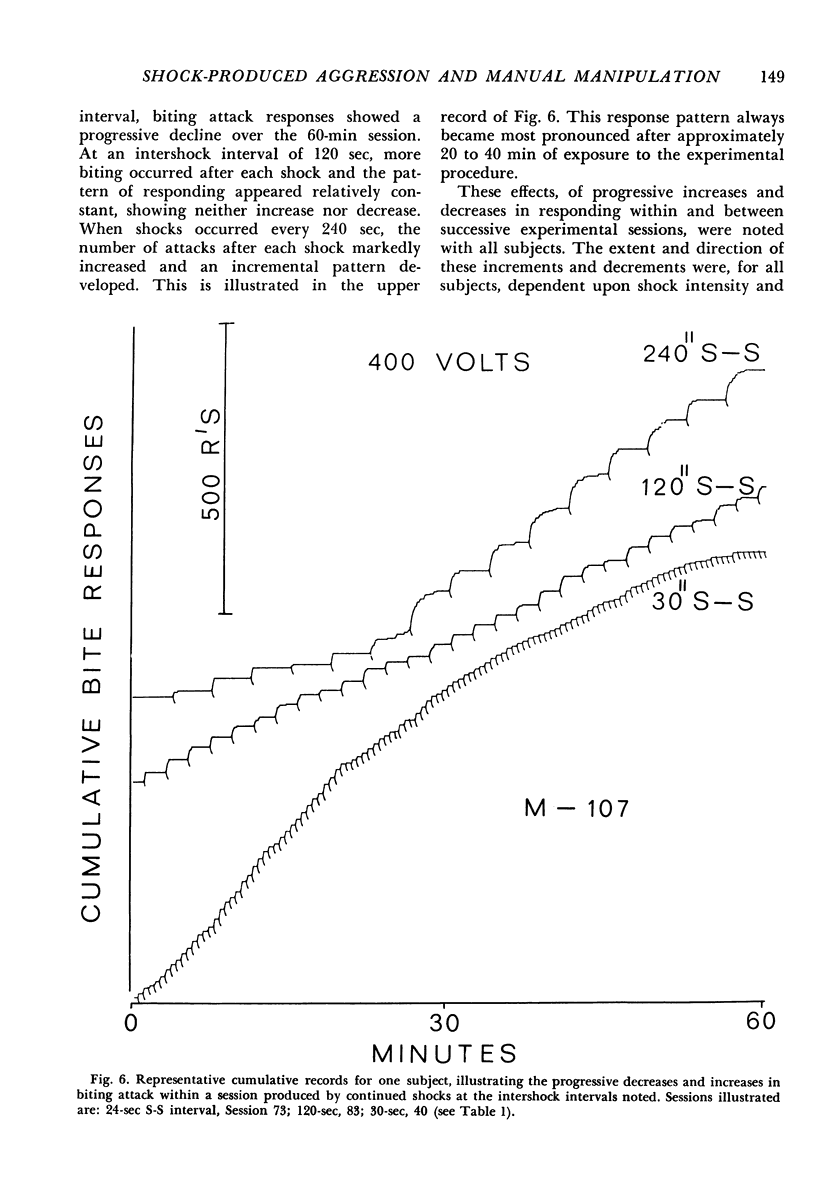


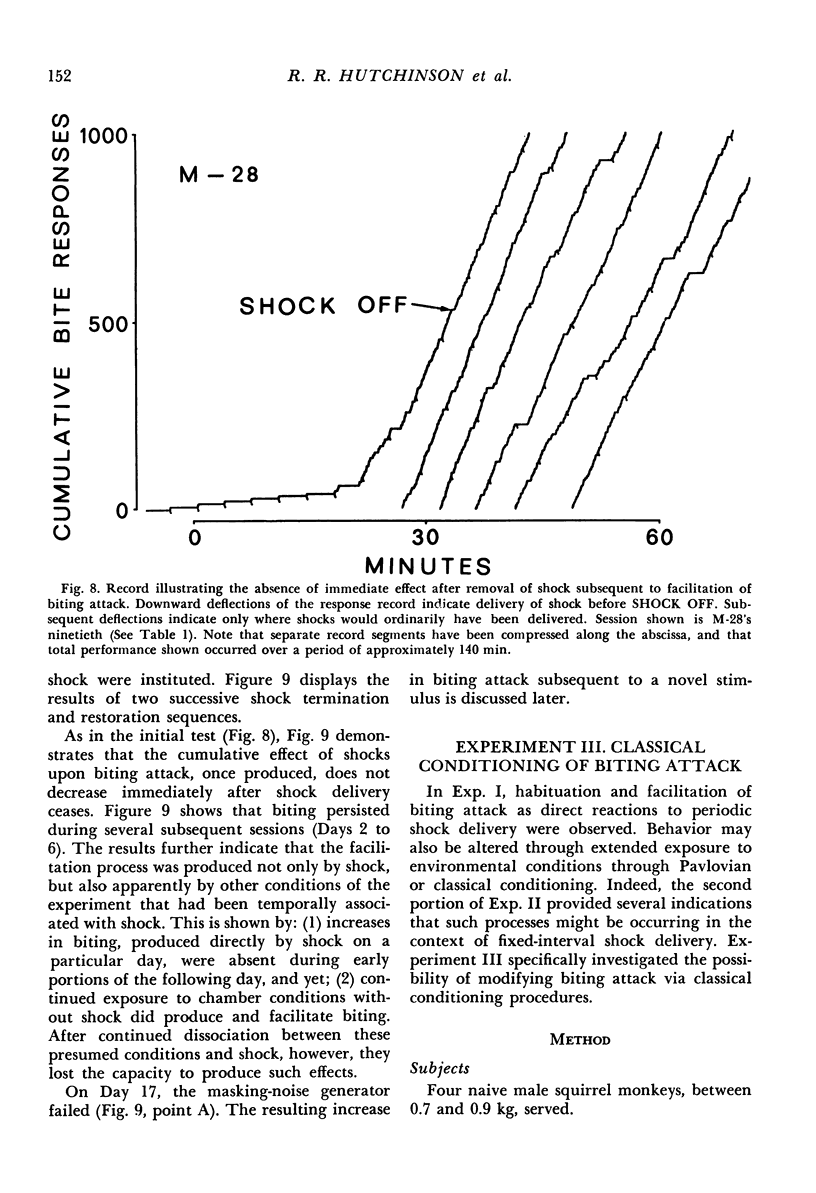
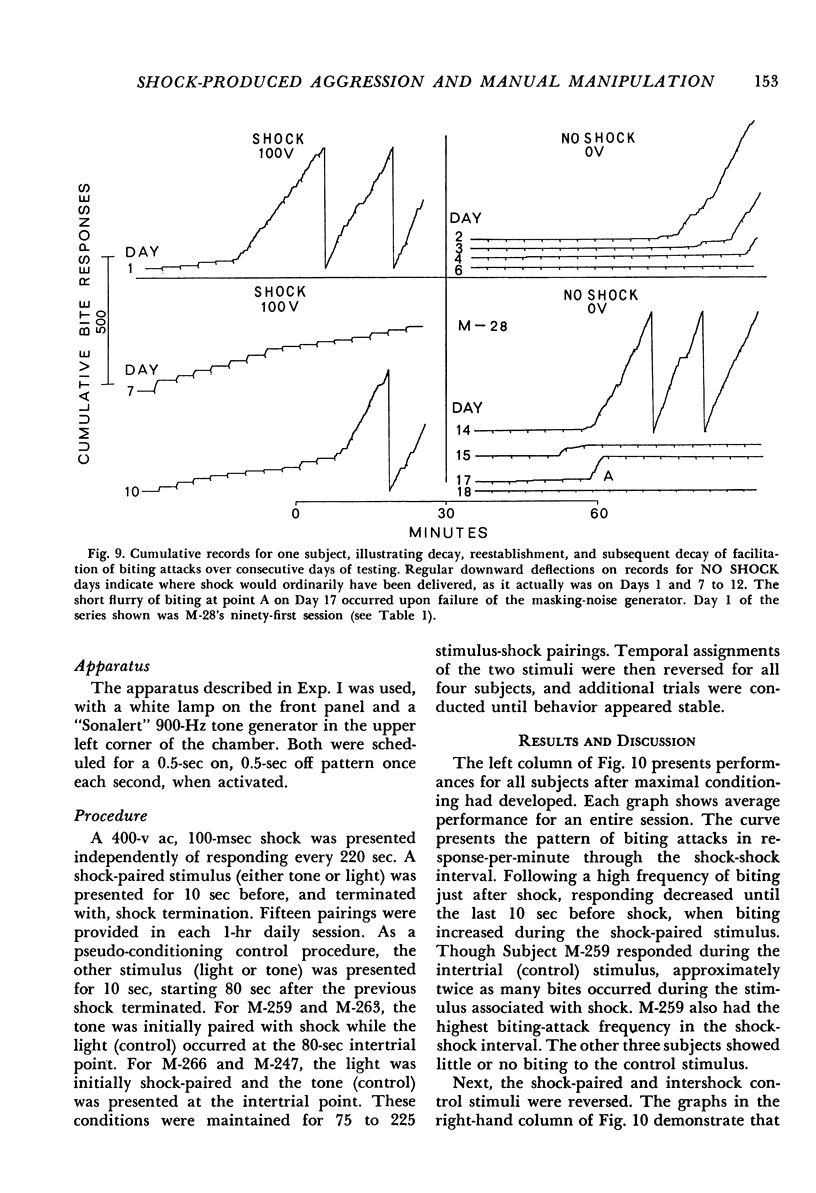
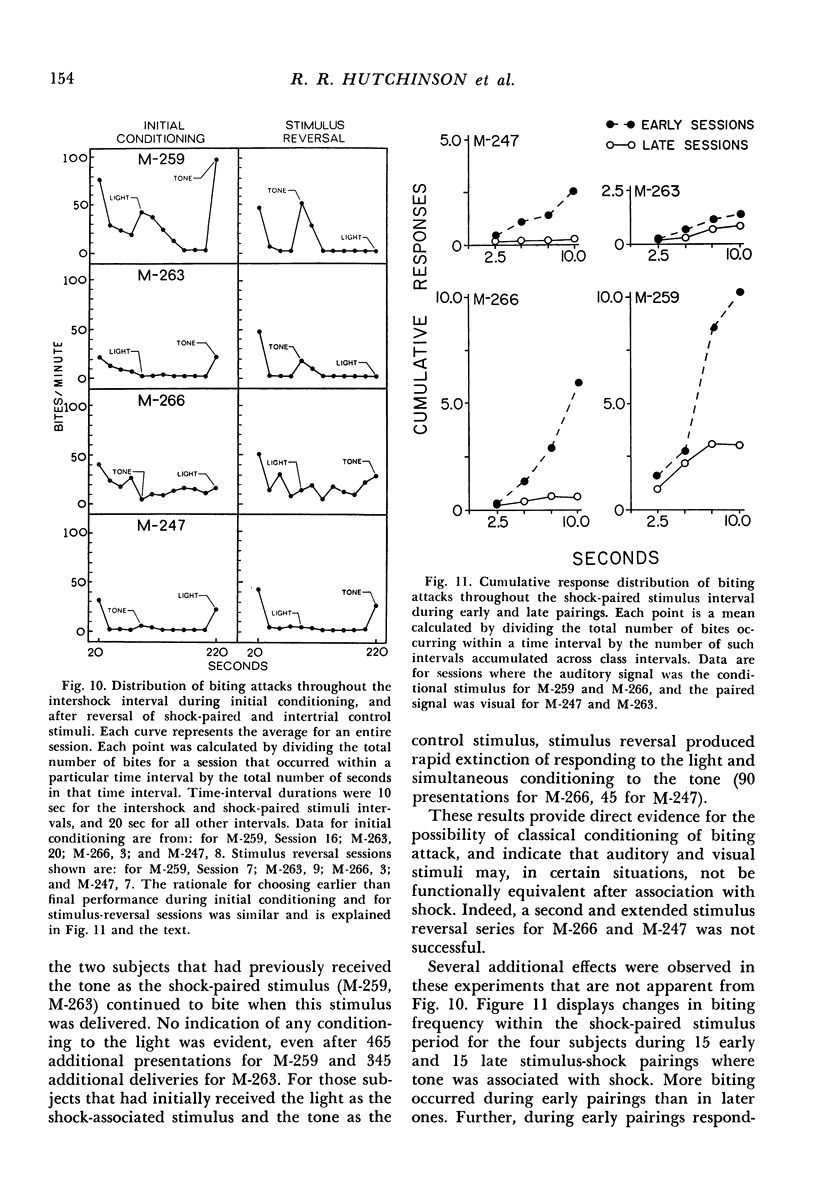

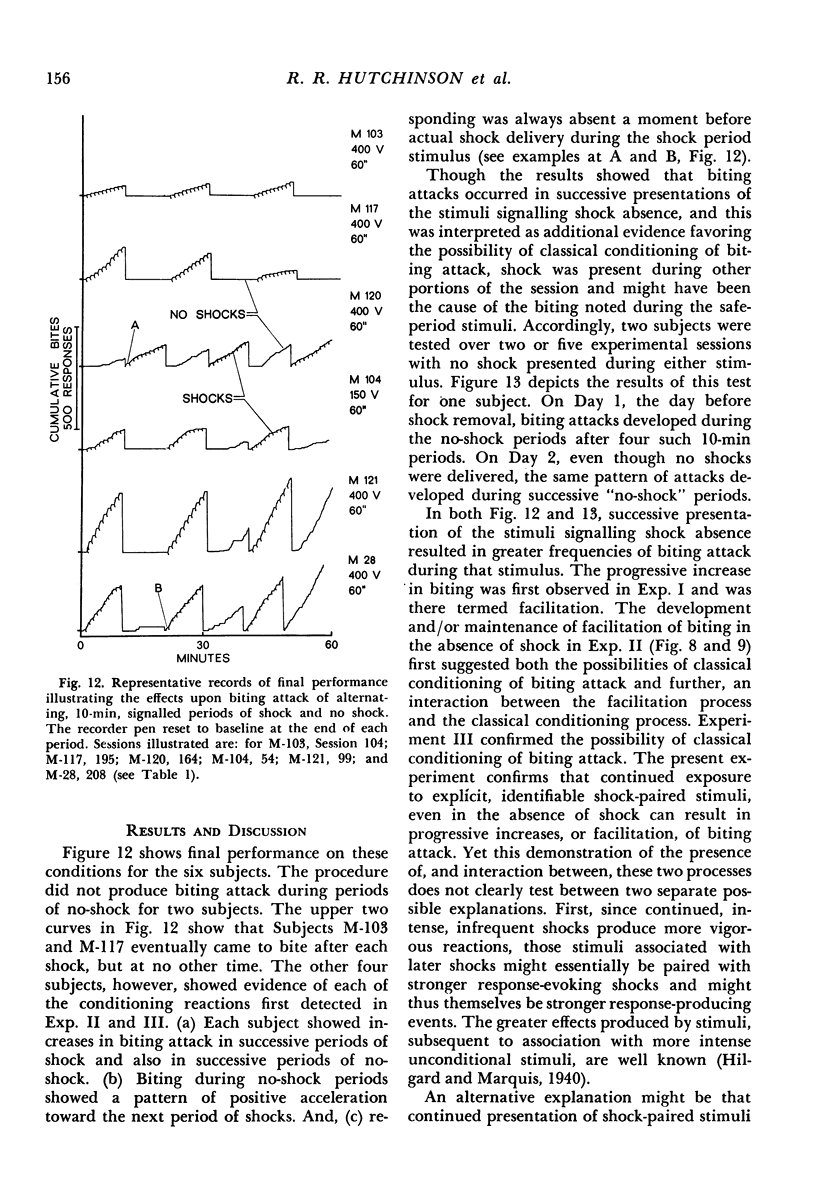
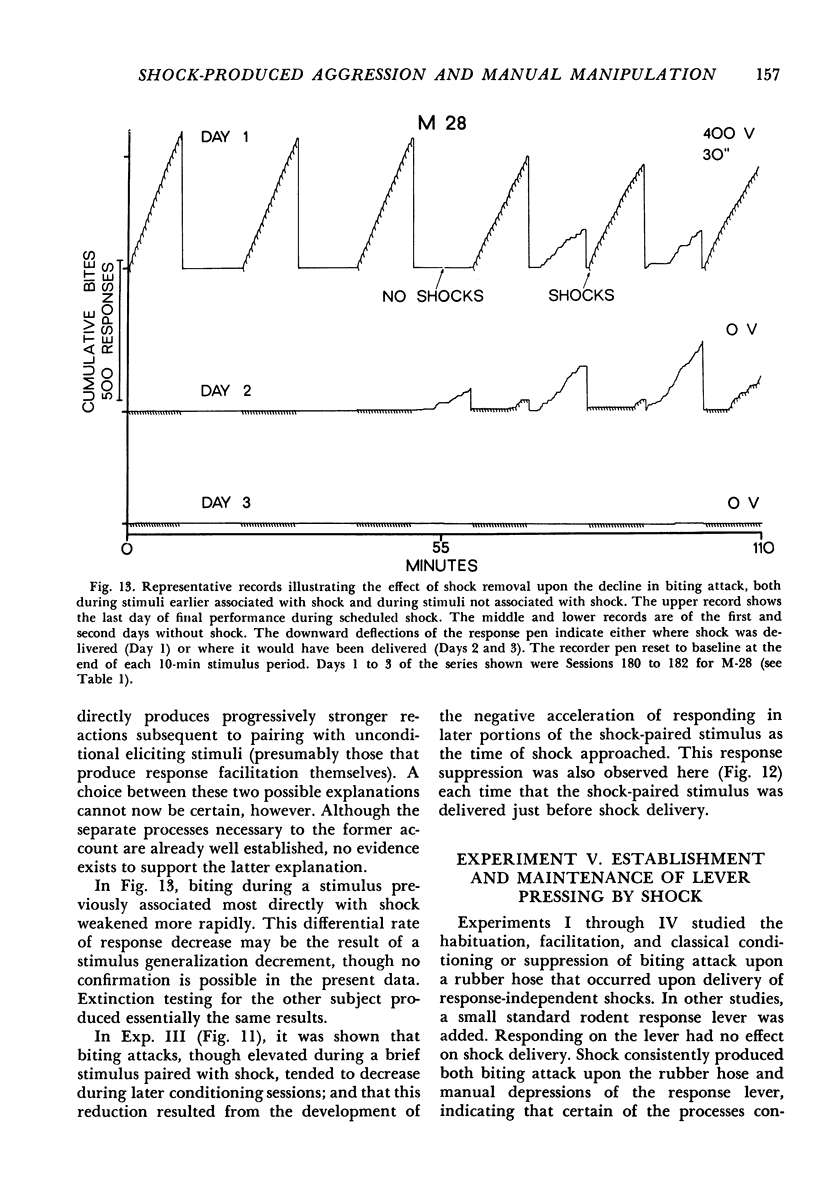
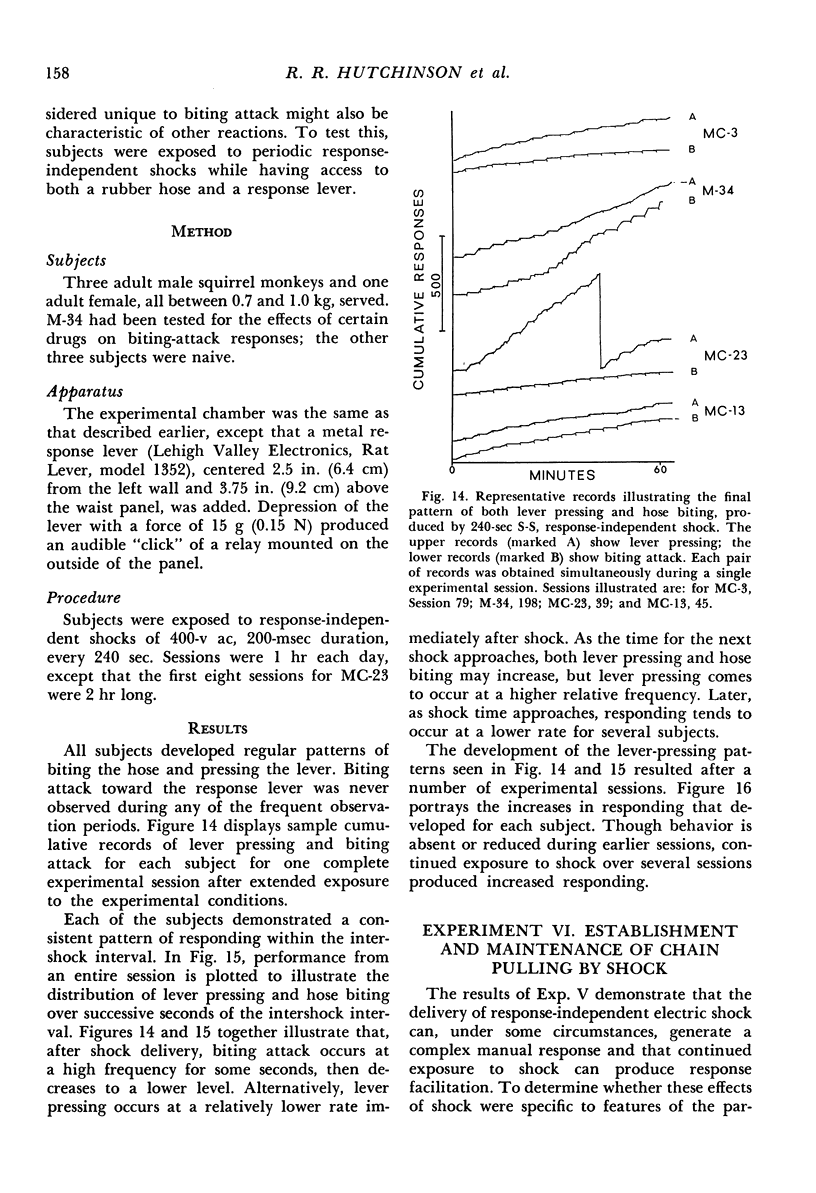
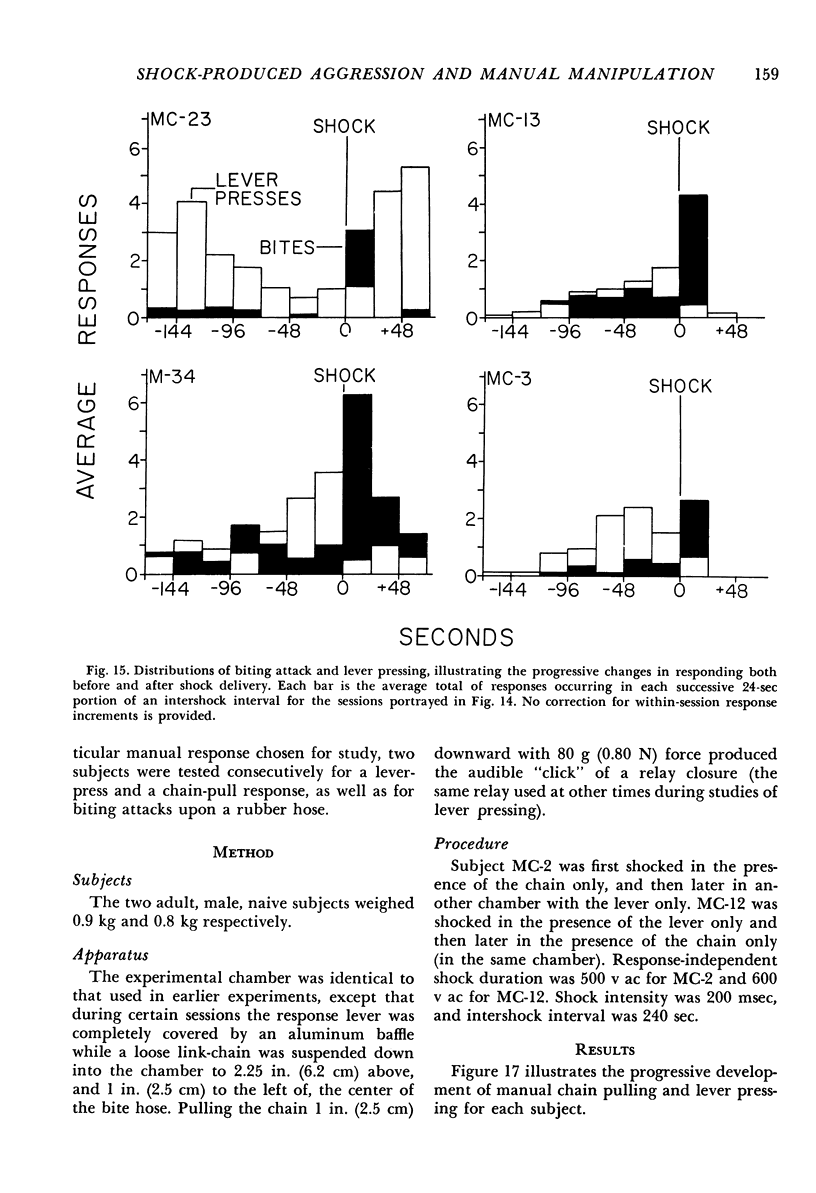


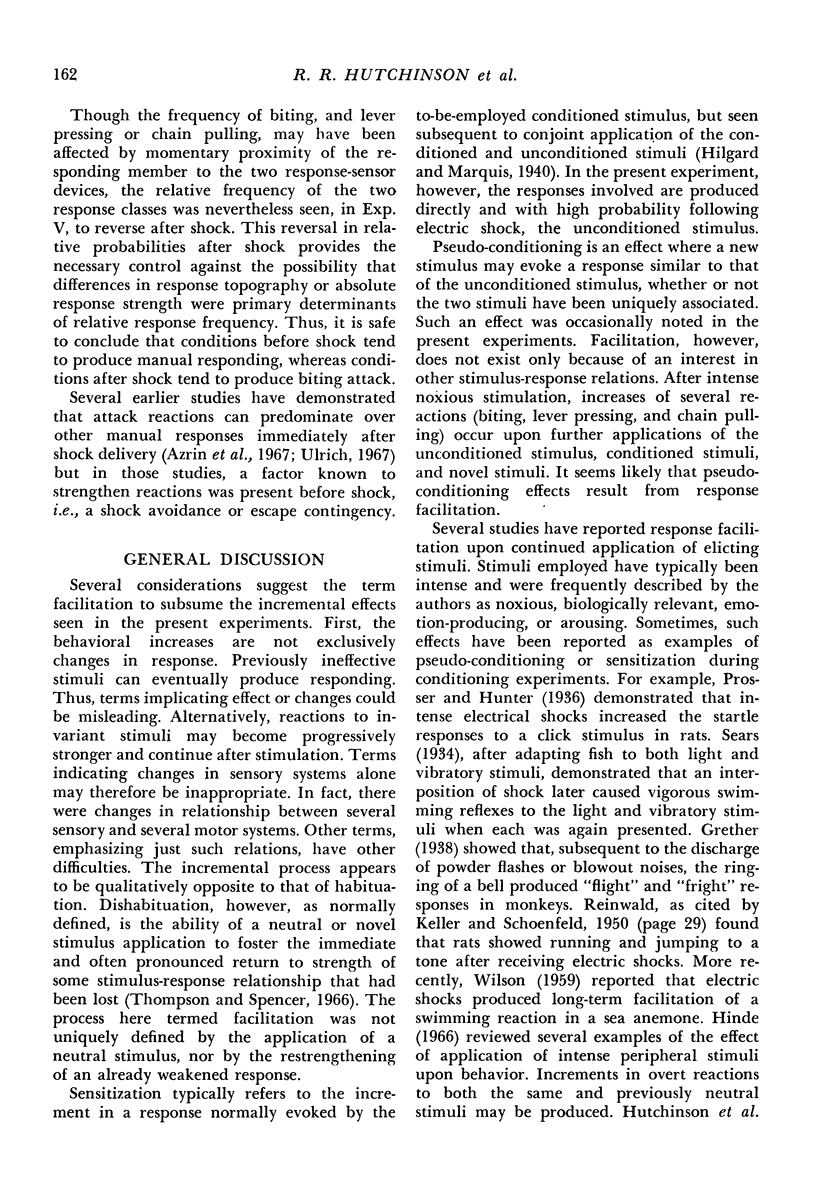
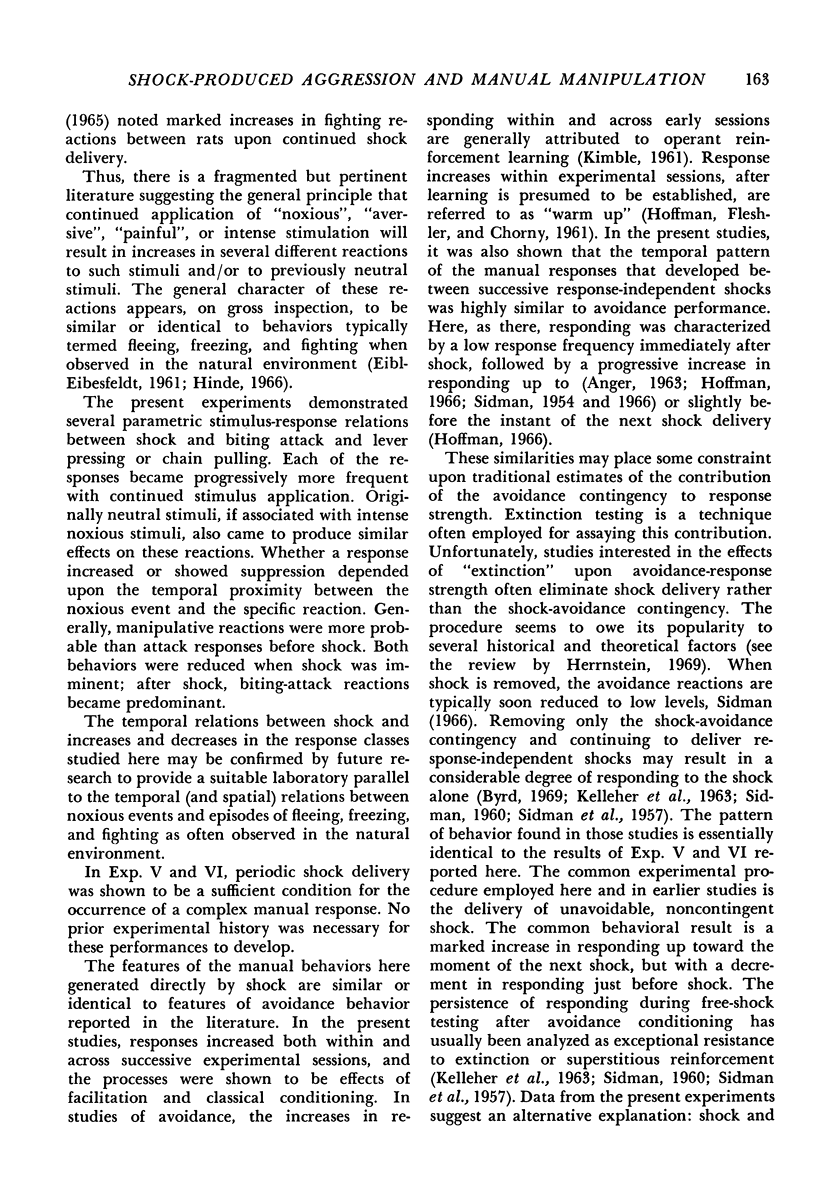
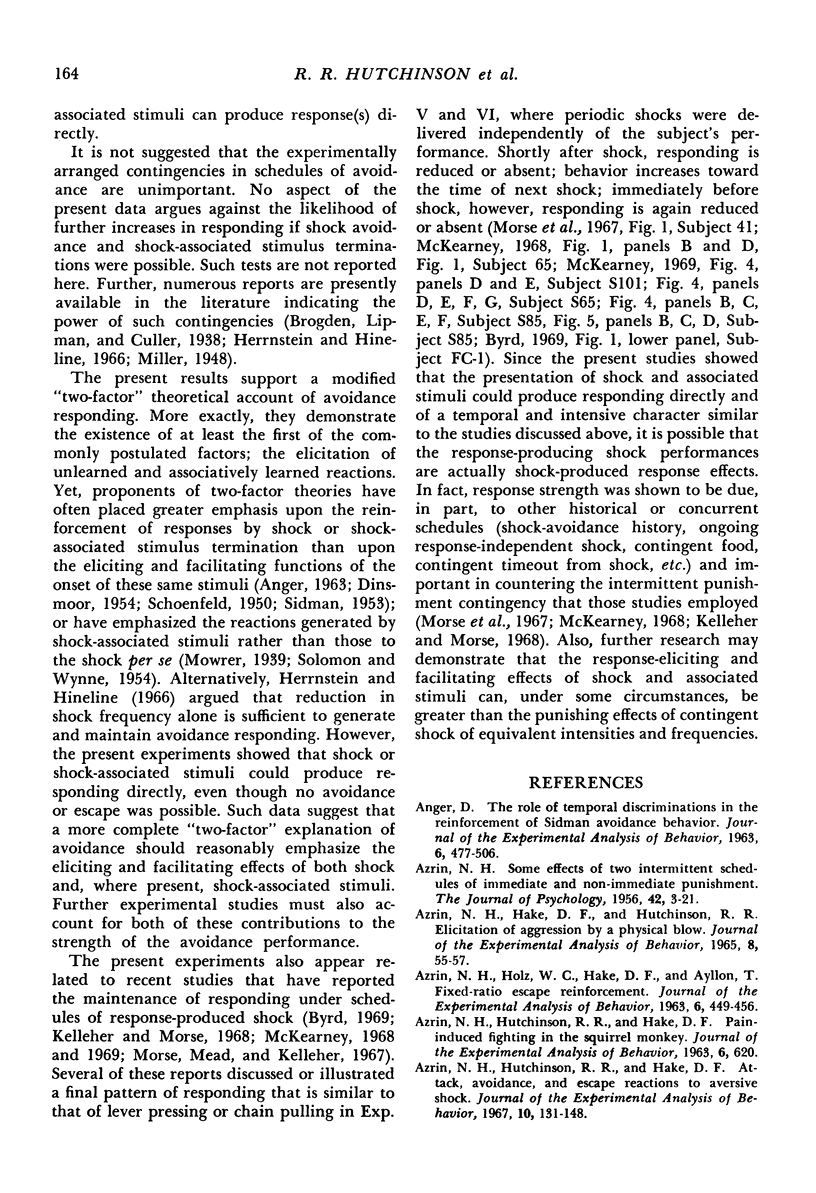
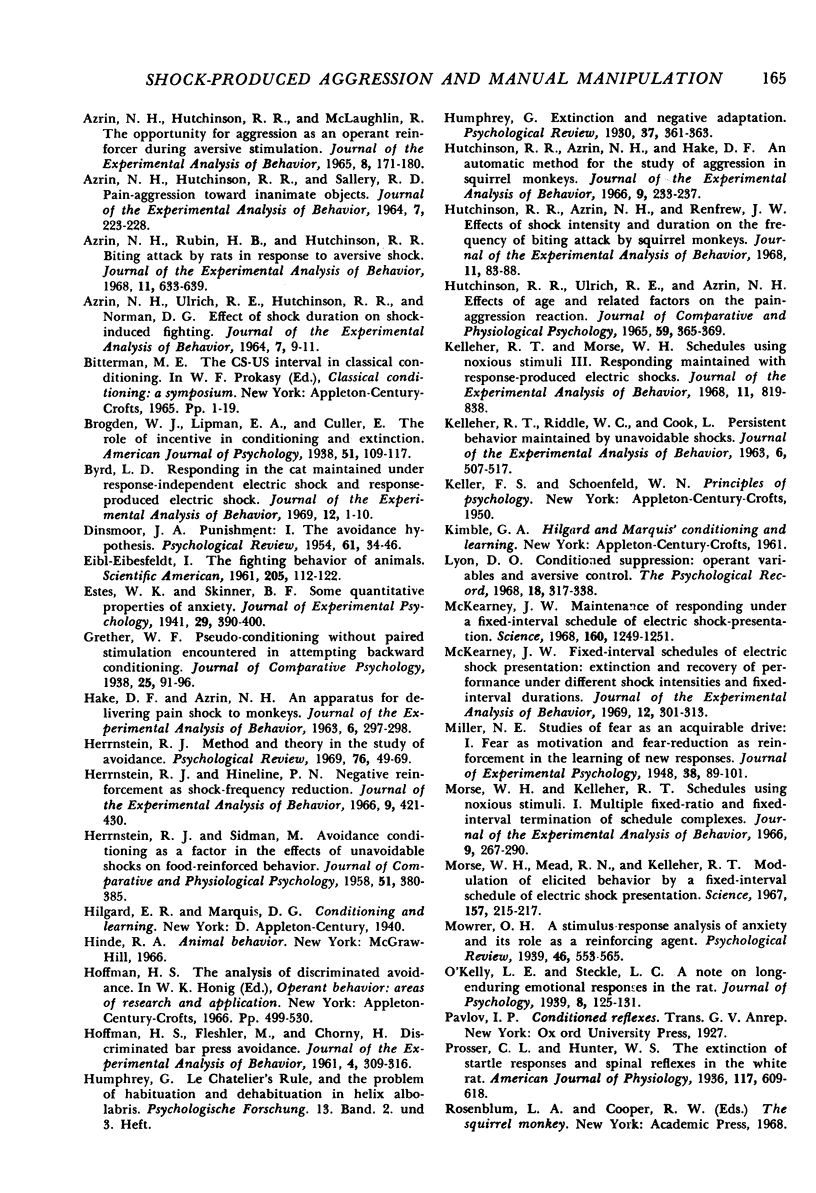
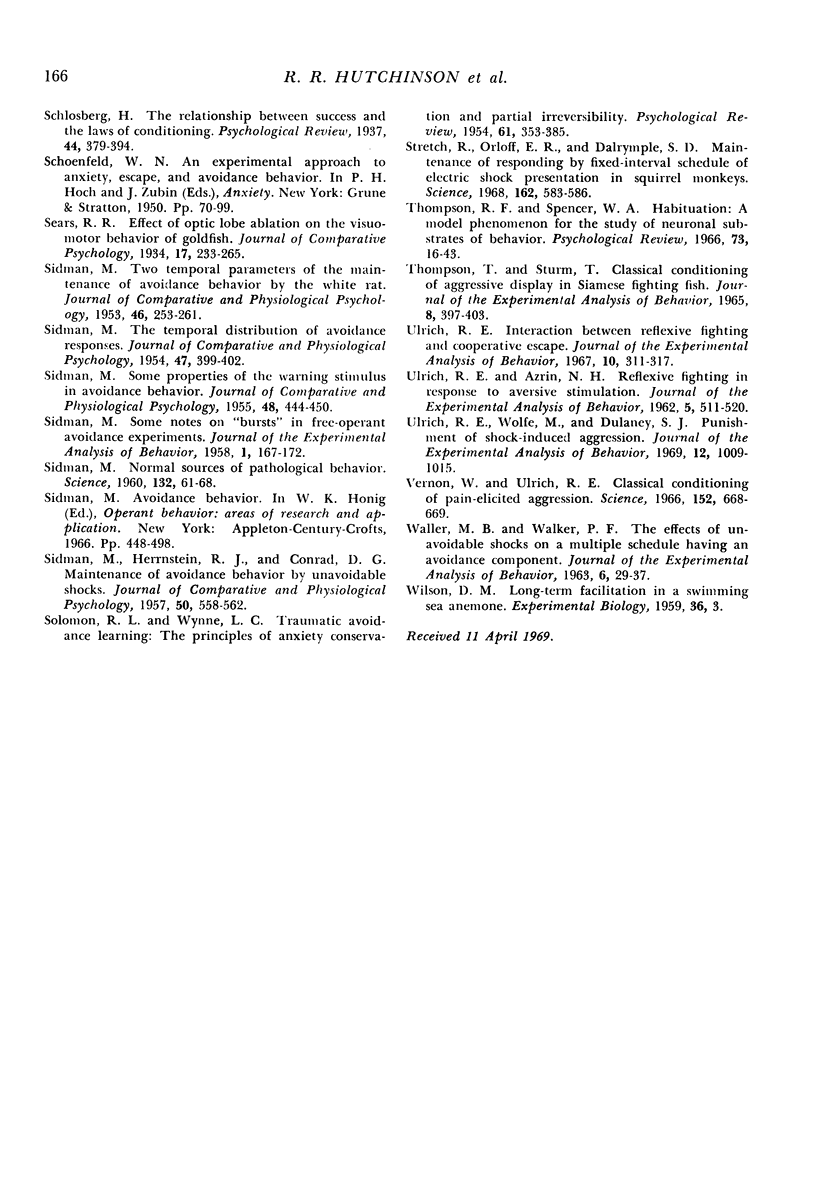
Selected References
These references are in PubMed. This may not be the complete list of references from this article.
- ANGER D. The role of temporal discriminations in the reinforcement of Sidman avoidance behavior. J Exp Anal Behav. 1963 Jul;6(3):477–506. doi: 10.1901/jeab.1963.6-s477. [DOI] [PMC free article] [PubMed] [Google Scholar]
- AZRIN N. H., HAKE D. F., HUTCHINSON R. R. ELICITATION OF AGGRESSION BY A PHYSICAL BLOW. J Exp Anal Behav. 1965 Jan;8:55–57. doi: 10.1901/jeab.1965.8-55. [DOI] [PMC free article] [PubMed] [Google Scholar]
- AZRIN N. H., HOLZ W. C., HAKE D. F., AYLLON T. Fixed-ratio escape reinforcement. J Exp Anal Behav. 1963 Jul;6:449–456. doi: 10.1901/jeab.1963.6-449. [DOI] [PMC free article] [PubMed] [Google Scholar]
- AZRIN N. H., HUTCHINSON R. R., HAKE D. F. PAIN-INDUCED FIGHTING IN THE SQUIRREL MONKEY. J Exp Anal Behav. 1963 Oct;6:620–620. doi: 10.1901/jeab.1963.6-620. [DOI] [PMC free article] [PubMed] [Google Scholar]
- AZRIN N. H., HUTCHINSON R. R., MCLAUGHLIN R. THE OPPORTUNITY FOR AGGRESSION AS AN OPERANT REINFORCER DURING AVERSIVE STIMULATION. J Exp Anal Behav. 1965 May;8:171–180. doi: 10.1901/jeab.1965.8-171. [DOI] [PMC free article] [PubMed] [Google Scholar]
- AZRIN N. H., HUTCHINSON R. R., SALLERY R. D. PAIN-AGGRESSION TOWARD INANIMATE OBJECTS. J Exp Anal Behav. 1964 May;7:223–228. doi: 10.1901/jeab.1964.7-223. [DOI] [PMC free article] [PubMed] [Google Scholar]
- AZRIN N. H., ULRICH R. E., HUTCHINSON R. R., NORMAN D. G. EFFECT OF SHOCK DURATION ON SHOCK-INDUCED FIGHTING. J Exp Anal Behav. 1964 Jan;7:9–11. doi: 10.1901/jeab.1964.7-9. [DOI] [PMC free article] [PubMed] [Google Scholar]
- Azrin N. H., Hutchinson R. R., Hake D. F. Attack, avoidance, and escape reactions to aversive shock. J Exp Anal Behav. 1967 Mar;10(2):131–148. doi: 10.1901/jeab.1967.10-131. [DOI] [PMC free article] [PubMed] [Google Scholar]
- Azrin N. H., Rubin H. B., Hutchinson R. R. Biting attack by rats in response to aversive shock. J Exp Anal Behav. 1968 Sep;11(5):633–639. doi: 10.1901/jeab.1968.11-633. [DOI] [PMC free article] [PubMed] [Google Scholar]
- Byrd L. D. Responding in the cat maintained under response-independent electric shock and response-produced electric shock. J Exp Anal Behav. 1969 Jan;12(1):1–10. doi: 10.1901/jeab.1969.12-1. [DOI] [PMC free article] [PubMed] [Google Scholar]
- DINSMOOR J. A. Punishment. I. The avoidance hypothesis. Psychol Rev. 1954 Jan;61(1):34–46. doi: 10.1037/h0062725. [DOI] [PubMed] [Google Scholar]
- HAKE D. F., AZRIN N. H. An apparatus for delivering pain shock to monkevs. J Exp Anal Behav. 1963 Apr;6:297–298. doi: 10.1901/jeab.1963.6-297. [DOI] [PMC free article] [PubMed] [Google Scholar]
- HERRNSTEIN R. J., SIDMAN M. Avoidance conditioning as a factor in the effects of unavoidable shocks on food-reinforced behavior. J Comp Physiol Psychol. 1958 Jun;51(3):380–385. doi: 10.1037/h0038487. [DOI] [PubMed] [Google Scholar]
- HOFFMAN H. S., FLESHLER M., CHORNY H. Discriminated bar-press avoidance. J Exp Anal Behav. 1961 Oct;4:309–316. doi: 10.1901/jeab.1961.4-309. [DOI] [PMC free article] [PubMed] [Google Scholar]
- HUTCHINSON R. R., ULRICH R. E., AZRIN N. H. EFFECTS OF AGE AND RELATED FACTORS ON THE PAIN-AGGRESSION REACTION. J Comp Physiol Psychol. 1965 Jun;59:365–369. doi: 10.1037/h0022046. [DOI] [PubMed] [Google Scholar]
- Herrnstein R. J., Hineline P. N. Negative reinforcement as shock-frequency reduction. J Exp Anal Behav. 1966 Jul;9(4):421–430. doi: 10.1901/jeab.1966.9-421. [DOI] [PMC free article] [PubMed] [Google Scholar]
- Herrnstein R. J. Method and theory in the study of avoidance. Psychol Rev. 1969 Jan;76(1):49–69. doi: 10.1037/h0026786. [DOI] [PubMed] [Google Scholar]
- Hutchinson R. R., Azrin N. H., Hake D. F. An automatic method for the study of aggression in squirrel monkeys. J Exp Anal Behav. 1966 May;9(3):233–237. doi: 10.1901/jeab.1966.9-233. [DOI] [PMC free article] [PubMed] [Google Scholar]
- Hutchinson R. R., Azrin N. H., Renfrew J. W. Effects of shock intensity and duration on the frequency of biting attack by squirrel monkeys. J Exp Anal Behav. 1968 Jan;11(1):83–88. doi: 10.1901/jeab.1968.11-83. [DOI] [PMC free article] [PubMed] [Google Scholar]
- KELLEHER R. T., RIDDLE W. C., COOK L. PERSISTENT BEHAVIOR MAINTAINED BY UNAVOIDABLE SHOCKS. J Exp Anal Behav. 1963 Oct;6:507–517. doi: 10.1901/jeab.1963.6-507. [DOI] [PMC free article] [PubMed] [Google Scholar]
- Kelleher R. T., Morse W. H. Schedules using noxious stimuli. III. Responding maintained with response-produced electric shocks. J Exp Anal Behav. 1968 Nov;11(6):819–838. doi: 10.1901/jeab.1968.11-819. [DOI] [PMC free article] [PubMed] [Google Scholar]
- McKearney J. W. Fixed-interval schedules of electric shock presentation: extinction and recovery of performance under different shock intensities and fixed-interval durations. J Exp Anal Behav. 1969 Mar;12(2):301–313. doi: 10.1901/jeab.1969.12-301. [DOI] [PMC free article] [PubMed] [Google Scholar]
- McKearney J. W. Maintenance of responding under a fixed-interval schedule of electric shock-presentation. Science. 1968 Jun 14;160(3833):1249–1251. doi: 10.1126/science.160.3833.1249. [DOI] [PubMed] [Google Scholar]
- Morse W. H., Kelleher R. T. Schedules using noxious stimuli. I. Multiple fixed-ratio and fixed-interval termination of schedule complexes. J Exp Anal Behav. 1966 May;9(3):267–290. doi: 10.1901/jeab.1966.9-267. [DOI] [PMC free article] [PubMed] [Google Scholar]
- Morse W. H., Mead R. N., Kelleher R. T. Modulation of elicited behavior by a fixed-interval schedule of electric shock presentation. Science. 1967 Jul 14;157(3785):215–217. doi: 10.1126/science.157.3785.215. [DOI] [PubMed] [Google Scholar]
- SIDMAN M., BOREN J. J. The use of shock-contingent variations in response-shock intervals for the maintenance of avoidance behavior. J Comp Physiol Psychol. 1957 Dec;50(6):558–562. doi: 10.1037/h0048927. [DOI] [PubMed] [Google Scholar]
- SIDMAN M. Some properties of the warning stimulus in avoidance behavior. J Comp Physiol Psychol. 1955 Dec;48(6):444–450. doi: 10.1037/h0047481. [DOI] [PubMed] [Google Scholar]
- SIDMAN M. The temporal distribution of avoidance responses. J Comp Physiol Psychol. 1954 Oct;47(5):399–402. doi: 10.1037/h0059155. [DOI] [PubMed] [Google Scholar]
- SIDMAN M. Two temporal parameters of the maintenance of avoidance behavior by the white rat. J Comp Physiol Psychol. 1953 Aug;46(4):253–261. doi: 10.1037/h0060730. [DOI] [PubMed] [Google Scholar]
- SOLOMON R. L., WYNNE L. C. Traumatic avoidance learning: the principles of anxiety conservation and partial irreversibility. Psychol Rev. 1954 Nov;61(6):353–385. doi: 10.1037/h0054540. [DOI] [PubMed] [Google Scholar]
- Sidman M. Normal Sources of Pathological Behavior. Science. 1960 Jul 8;132(3419):61–68. doi: 10.1126/science.132.3419.61. [DOI] [PubMed] [Google Scholar]
- Sidman M. Some Notes on "Bursts" in Free-operant Avoidance Experiments. J Exp Anal Behav. 1958 Apr;1(2):167–172. doi: 10.1901/jeab.1958.1-167. [DOI] [PMC free article] [PubMed] [Google Scholar]
- Stretch R., Orloff E. R., Dalrymple S. D. Maintenance of responding by fixed-interval schedule of electric shock presentation in squirrel monkeys. Science. 1968 Nov 1;162(3853):583–586. doi: 10.1126/science.162.3853.583. [DOI] [PubMed] [Google Scholar]
- Thompson R. F., Spencer W. A. Habituation: a model phenomenon for the study of neuronal substrates of behavior. Psychol Rev. 1966 Jan;73(1):16–43. doi: 10.1037/h0022681. [DOI] [PubMed] [Google Scholar]
- Thompson T., Sturm T. Classical conditioning of aggressive display in Siamese fighting fish. J Exp Anal Behav. 1965 Nov;8(6):397–403. doi: 10.1901/jeab.1965.8-397. [DOI] [PMC free article] [PubMed] [Google Scholar]
- ULRICH R. E., AZRIN N. H. Reflexive fighting in response to aversive stimulation. J Exp Anal Behav. 1962 Oct;5:511–520. doi: 10.1901/jeab.1962.5-511. [DOI] [PMC free article] [PubMed] [Google Scholar]
- Ulrich R. Interaction between reflexive fighting and cooperative escape. J Exp Anal Behav. 1967 May;10(3):311–317. doi: 10.1901/jeab.1967.10-311. [DOI] [PMC free article] [PubMed] [Google Scholar]
- Ulrich R., Wolfe M., Dulaney S. Punishment of shock-induced aggression. J Exp Anal Behav. 1969 Nov;12(6):1009–1015. doi: 10.1901/jeab.1969.12-1009. [DOI] [PMC free article] [PubMed] [Google Scholar]
- Vernon W., Ulrich R. Classical conditioning of pain-elicited aggression. Science. 1966 Apr 29;152(3722):668–669. doi: 10.1126/science.152.3722.668. [DOI] [PubMed] [Google Scholar]
- WALLER M. B., WALLER P. F. The effects of unavoidable shocks on a multiple schedule having an avoidance component. J Exp Anal Behav. 1963 Jan;6:29–37. doi: 10.1901/jeab.1963.6-29. [DOI] [PMC free article] [PubMed] [Google Scholar]


